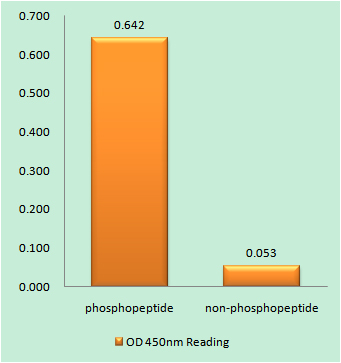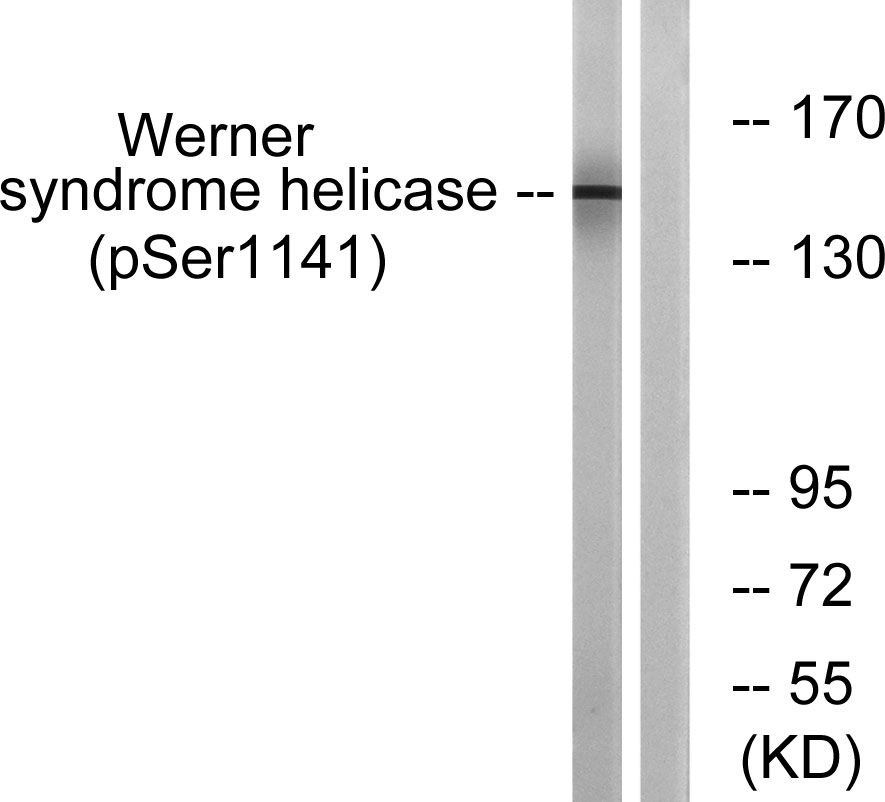WRN (phospho Ser1141) Polyclonal Antibody
- Catalog No.:YP0401
- Applications:WB;ELISA
- Reactivity:Human;Rat;Mouse;
- Target:
- WRN
- Gene Name:
- WRN
- Protein Name:
- Werner syndrome ATP-dependent helicase
- Human Gene Id:
- 7486
- Human Swiss Prot No:
- Q14191
- Mouse Swiss Prot No:
- O09053
- Immunogen:
- The antiserum was produced against synthesized peptide derived from human Werner Syndrome Helicase around the phosphorylation site of Ser1141. AA range:1107-1156
- Specificity:
- Phospho-WRN (S1141) Polyclonal Antibody detects endogenous levels of WRN protein only when phosphorylated at S1141.
- Formulation:
- Liquid in PBS containing 50% glycerol, 0.5% BSA and 0.02% sodium azide.
- Source:
- Polyclonal, Rabbit,IgG
- Dilution:
- WB 1:500 - 1:2000. ELISA: 1:5000. Not yet tested in other applications.
- Purification:
- The antibody was affinity-purified from rabbit antiserum by affinity-chromatography using epitope-specific immunogen.
- Concentration:
- 1 mg/ml
- Storage Stability:
- -15°C to -25°C/1 year(Do not lower than -25°C)
- Other Name:
- WRN;RECQ3;RECQL2;Werner syndrome ATP-dependent helicase;DNA helicase; RecQ-like type 3;RecQ3;Exonuclease WRN;RecQ protein-like 2
- Observed Band(KD):
- 162kD
- Background:
- Werner syndrome RecQ like helicase(WRN) Homo sapiens This gene encodes a member of the RecQ subfamily and the DEAH (Asp-Glu-Ala-His) subfamily of DNA and RNA helicases. DNA helicases are involved in many aspects of DNA metabolism, including transcription, replication, recombination, and repair. This protein contains a nuclear localization signal in the C-terminus and shows a predominant nucleolar localization. It possesses an intrinsic 3' to 5' DNA helicase activity, and is also a 3' to 5' exonuclease. Based on interactions between this protein and Ku70/80 heterodimer in DNA end processing, this protein may be involved in the repair of double strand DNA breaks. Defects in this gene are the cause of Werner syndrome, an autosomal recessive disorder characterized by premature aging. [provided by RefSeq, Jul 2008],
- Function:
- disease:Defects in WRN are a cause of Werner syndrome (WRN) [MIM:277700]. WRN is a rare autosomal recessive progeroid syndrome characterized by the premature onset of multiple age-related disorders, including atherosclerosis, cancer, non-insulin-dependent diabetes mellitus, ocular cataracts and osteoporosis. The major cause of death, at a median age of 47, is myocardial infarction. Currently all known WS mutations produces prematurely terminated proteins.,disease:Defects in WRN may be a cause of colorectal cancer (CRC) [MIM:114500].,function:Essential for the formation of DNA replication focal centers; stably associates with foci elements generating binding sites for RP-A. Exhibits a magnesium-dependent ATP-dependent DNA-helicase activity. May be involved in the control of genomic stability.,online information:WRN mutation db (Warner disease),PTM:Phosphorylated by PRKDC. Phosphorylated u
- Subcellular Location:
- Nucleus, nucleolus . Nucleus . Nucleus, nucleoplasm . Chromosome . Gamma-irradiation leads to its translocation from nucleoli to nucleoplasm and PML regulates the irradiation-induced WRN relocation (PubMed:21639834). Localizes to DNA damage sites (PubMed:27063109). .
- Expression:
- Spleen,
- June 19-2018
- WESTERN IMMUNOBLOTTING PROTOCOL
- June 19-2018
- IMMUNOHISTOCHEMISTRY-PARAFFIN PROTOCOL
- June 19-2018
- IMMUNOFLUORESCENCE PROTOCOL
- September 08-2020
- FLOW-CYTOMEYRT-PROTOCOL
- May 20-2022
- Cell-Based ELISA│解您多样本WB检测之困扰
- July 13-2018
- CELL-BASED-ELISA-PROTOCOL-FOR-ACETYL-PROTEIN
- July 13-2018
- CELL-BASED-ELISA-PROTOCOL-FOR-PHOSPHO-PROTEIN
- July 13-2018
- Antibody-FAQs
- Products Images

- Enzyme-Linked Immunosorbent Assay (Phospho-ELISA) for Immunogen Phosphopeptide (Phospho-left) and Non-Phosphopeptide (Phospho-right), using Werner Syndrome Helicase (Phospho-Ser1141) Antibody

- Western blot analysis of lysates from K562 cells treated with etoposide 25uM 24h, using Werner Syndrome Helicase (Phospho-Ser1141) Antibody. The lane on the right is blocked with the phospho peptide.



